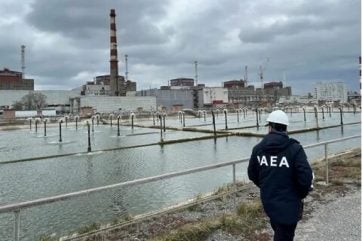
The nuclear safety and security situation in Ukraine remains fragile because of the armed conflict, with International Atomic Energy Agency (IAEA) staff continuing to hear the sound of military activities close to some of the sites, IAEA Director General Rafael Mariano Grossi said in his latest update.
“During the third year of this tragic war, the dangers to nuclear safety and security are still all too real. We are determined to continue our efforts to help prevent a nuclear accident,” he noted.
At the Zaporizhia NPP (ZNPP) this week, the IAEA team requested and was granted access to a transport workshop four kilometres from the plant following a reported drone attack there on 7 September. They observed a hole in one roof and two trucks that were slightly impacted. The team did not see any damage relevant to nuclear safety and security.
In addition, the IAEA team conducted a walkdown of the electrical and the instrumentation and control rooms of reactor unit 4, and the turbine halls of units 1 and 2. Access to the western part of the turbine halls was once again not granted.
Earlier, the IAEA team held discussions with the ZNPP regarding the new emergency plan that is expected to come into effect by the end of September, and about a planned emergency exercise. As was the case in previous exercises at the ZNPP, the IAEA team will observe the exercise.
Meanwhile, Russian Permanent Representative to International Organisations in Vienna Mikhail Ulyanov told Rossiya 24 that Grossi, the agency’s staff and almost all delegations of countries know that the attacks on ZNPP are being conducted by Ukraine, but there is no evidence, and irrefutable facts are needed. “I know that he (Grossi), his staff and, by the way, almost all the delegations to the IAEA, are well aware that the attacks on the station are carried out by Ukraine, but Grossi really has no evidence of this. We need irrefutable facts here, ” he said. He added that the drones attacking the station move along an unclear trajectory, and it is impossible to prove that they are controlled by the Ukrainian military.
Elsewhere in Ukraine, IAEA teams present at the Khmelnitsky, Rivne and South Ukraine NPPs and the Chornobyl site reported that nuclear safety and security is being maintained despite the effects of the ongoing conflict, including air raid alarms on several days over the past week.
Recently one of the 330 kV off-site power lines at the Chornobyl site was disconnected for about 40 minutes due to a technical issue that was quickly resolved. The following day at the Rivne NPP, a 750 kV line that had been cut since the attacks in late August was reconnected.
At the South Ukraine NPP, on two recent occasions the IAEA team heard drones and gunfire and was told to shelter, highlighting persistent risks to the Ukrainian NPPs. Following last week’s incident, the plant and the State Nuclear Regulatory Inspectorate of Ukraine (SNRIU) said drones had flown close to the plant. The IAEA team did not observe any issues with respect to nuclear safety or security at the site following this event. SNRIU reported to the IAEA that drones had also been observed flying in the area surrounding the Khelmnitsky NPP early in the morning.
The Agency continued delivering on its comprehensive programme of assistance to help Ukraine maintain nuclear safety and security. With a total of 63 deliveries since the start of the armed conflict, equipment worth over €11m ($12.1m) has so far reached different organisations in Ukraine.
The Chornobyl site has received beds to improve the living conditions of its staff. In addition, equipment and other supplies were delivered to support the Ministry of Energy in ensuring reliable power supplies to and from the NPPs. The delivery took place following a Ministry request related to the needs of Ukrainian electricity distribution operators and included electrical wires and switches, as well as protection and control microprocessor devices for substations and switchgear. The assistance was supported with funds from France, Japan, New Zealand, and Norway.
In other developments, the IAEA has carried out its first visit to an electrical substation in Ukraine, as part of its work to assess the status of the electrical grid infrastructure essential to nuclear safety. At the visit to the Kyivska site, the IAEA team observed damage sustained earlier but also noted that, following repairs, the substation is now back to full capacity.
“Assessing the status of substations is a significant new element of our work in Ukraine, as the safety of operating nuclear power plants is dependent on a stable grid connection. In recent weeks and months, the situation has become increasingly precarious in this regard. As experts in nuclear safety and related infrastructure, it is important that we get a first-hand view of the status of the substations,” Grossi said.






